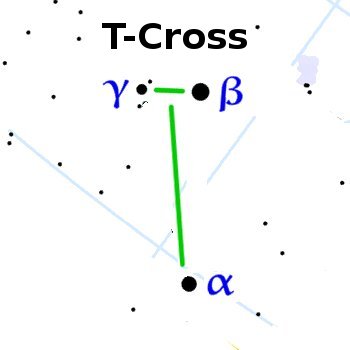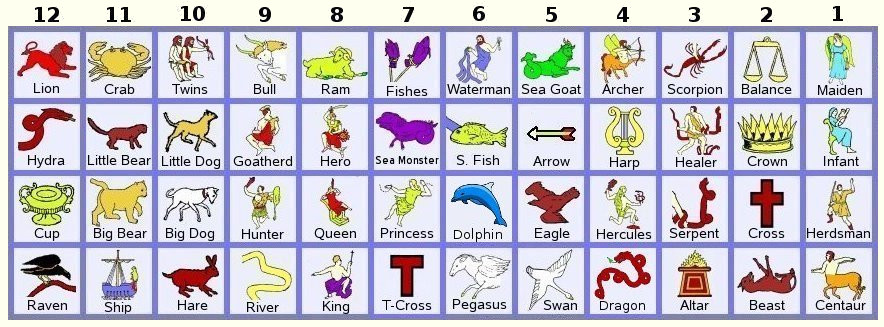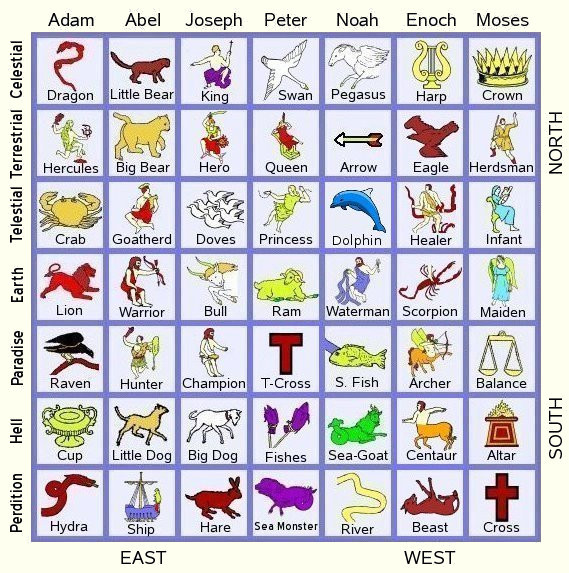
(Click for Triangulum constellation.)
by John P. Pratt
30 May 2017, 1 Wind (SR), 1 Quickening (Ma), Tiara (US), 1 Lord (M, UM)
©2017 by John P. Pratt. All rights Reserved.
| 1. T-Cross Replaces Southern Crown |
| 2. Conclusion |
| Notes |
The last few weeks have been devoted to attempting to determine which stars represent each day of the year on the Star Calendar.[1] Surprisingly, that task has been made possible by recognizing several governing principles. Until now, only the brightest stars for the holy days had been identified in that calendar. An unexpected benefit of that research was that one of the constellations on my restored ancient list of 48 now appears to be wrong. This article discusses evidence for another constellation to take its place. Now the list of 48 constellations finally appears to be complete.
One of the principal tasks required to discover the Star Calendar has been to discover exactly which constellations are included, what stars they comprise, and then exactly which subset of those stars is represented on the calendar. While virtually every ancient list includes exactly 48 constellations, each list differed as to which constellations those were. It is as if they all knew there had been 48, but some had been lost so others were invented to replace them.
Until this last week or so, the list was known down to within a choice of two constellations to fill the last slot. Let us now see how the constraints on fitting the constellations into the Star Calendar eliminated one choice and clearly indicated the other.
The Star Calendar assigns one star to each day of the year. The stars are assigned according to their location in the heavens. The apparent annual path of the sun through the stars (caused by the earth orbiting the sun) means that the sun looks like it moves about 1° per day through the background stars which its brightness obscures. For the Star Calendar, that path is divided into 364 "slots" of nearly 1° width each. A line is drawn from each star perpendicularly to the path of the sun and whatever slot it falls into is the day indicated for that star. Only one star is allowed to fill each slot.
There are about 1,000 visible stars that are associated with the constellation figures and only 364 days in the star year (plus 7 extra in leap years). Some areas of the sky are filled with many stars, so the choice of exactly which stars can be in included requires some selection criteria. Some of those constraints are that the stars must be essential to the figure, be symbolically meaningful, and they must fall within a day or so of the slot indicated for them by their position in the sky. Let us see how these constraints, and especially that of not having enough slots in crowded areas of the sky, made the choice between two competing constellations easy.
An earlier article discussed the pros and cons of choosing between two candidate constellations to fill the last slot on the list of 48: the Triangle and the Southern Crown. It was decided that the very dim and poorly attested Southern Crown still seemed a better choice than the bright and well known Triangle. The only reason for rejecting the Triangle was that it did not fit the pattern of meaningful symbolism but instead seemed like something an unimaginative astronomer would fabricate to fill a gap. Other than that, it has excellent credentials of authenticity. The Southern Crown, on the other hand, had the symbolism of a victor's wreath given to heroes, of which there were ample represented in the heavens.[2]
Now the weight of evidence has totally changed to overwhelmingly favor the Triangle. Here's why.
First, there is not room in the Star Calendar for even one star from the very dim Southern Crown. It is in a crowded section of sky. My initial attempt at the star list had only one star from this constellation to represent it, but it was soon forced out by the criterion to include all essential stars.
After the Southern Crown had been eliminated as a candidate due to its location in the heavens, a fresh look was attempted to reconsider the Triangle. It is a relatively bright little triangle somewhat below the Princess (Andromeda). When its location was analyzed, there were indeed three slots available in the sparsely populated area near the Ram. Not only was there room for all three stars, but one of those slots was a game changer!
One of the stars fits perfectly into the slot of the day on which the Savior was crucified! Until now, that had been just a random star day, filled with a dim star which was a place holder expected to be replaced. Now a potential replacement had indeed appeared.
 |
Combining that new vision with the Crucifixion having occurred on what could be represented by one of those stars, the question arose as to the shape of the cross on which Jesus was crucified. It turns out that the Romans used a variety of shapes: cross-shaped, T-shaped, X-shaped and a simple I-shaped pole. The Greek word used in the New Testament can refer to a simple pole, which has led some to conclude that such was mostly likely the instrument of execution for the Savior.
Given that there are no references in the Bible to the exact shape of the cross, we can ask if there are any extant traditions from the early Church about the shape of the cross on which Christ was crucified. Apparently the earliest is from the Epistle of Barnabas, thought to have been written about AD 100. It states:
"the cross in the 'T' was to have grace" — Ep. Barnabas 9:7 [3]
The author of this Greek epistle was trying to prove a point using the shape of the cross of Jesus, which was apparently well known to have been shaped like the Greek letter tau. A capital tau is identical to an English capital "T". For the purposes of this article, the important point is that it was common knowledge that the cross had been T-shaped.
 |
A powerful second witness to this identification is that the day which was proposed in 2006 in my articles for the death of Joshua occurred on the same star day of the T-cross as the death of Jesus. Keeping in mind that Joshua and Jesus are essentially the same name in Hebrew (Jesus=Jeshua), that provides another direct tie between Joshua and Jesus besides their names being the same.
Now let's look at how this proposed constellation of the T-Cross fits into both the constellation patterns of the 4x12 grid of 48 and the 7x7 grid of 49 constellations.
Figure 3 shows icons with English names representing the 48 constellations. The twelve of the zodiac appear on the top row as they appear in the heavens, wrapping around the entire circle of the heavens through which the sun appears to move each year. Thus, the Maiden (top right) in the sky is next to the back feet of the Lion (top left). Below them are three constellations that are either above or below the zodiac, or possibly one constellation to the side. Each is associated with at least one adjacent to it. The wreath had appeared in the bottom row under the Eagle. The illustration shows it removed, with the Swan and Pegasus moved to the right so that the T-Cross fits into its place under Andromeda where it is found in the sky. In favor of this arrangement, both Cygnus and Pegasus fit better in their new columns; they had been moved to the left to make room for the Wreath. Clicking on Figure 3 toggles between the old and new version.[4]
 |
When we consider the 7x7 grid of 49 constellations, it provides compelling evidence that Triangulum is the correct constellation when considered to be a T-cross. This pattern is actually a map of the entire sky: the constellations appear in their actual locations not only east and west (rows) but also north and south (columns). The largest allowed discrepancy to that rule is to be one position in the table too low or high or left or right. What is amazing is that each column is associated with a different of the seven chief angels and each row is associated with one of seven levels of spirituality with the highest being nearest the ecliptic pole (like the north pole if the zodiac circle were the equator).
Look at the grid in Figure 4. This pattern alone provides compelling evidence that the constellations are not merely the product of fanciful imaginations of shepherds with insomnia! When the symbolism of the figures is understood, there is complete order to these figures.
 |
 |
Clicking on Figure 4 toggles between the old and new versions. Doing so shows something else. Formerly, the 49 grid was short one constellation, so the Fishes were broken into two parts: the Fishes and the Bands. That had been done by other researchers, but it has always seemed forced and unnatural to me. Having this new constellation fill that slot is much more satisfying. The Fishes appear below the T-Cross on the new version because they are attached to the great and abominable Sea Monster which must be located on the bottom (most evil) row. That tends to drag the Fishes down to hell unless they are freed by the Ram (Christ). The Ram is in the middle row because it contains only zodiac constellations. Moreover, note that this arrangement puts the Ram, one of the clearest representations of Christ as the Lamb of God, at the very center of the chart. That also feels right.
The T-Cross also fits into a slot in the row representing paradise. That is also a perfect fit, while at the same time illustrating the difference between this cross and the one found on the bottom row. The cross on the bottom row of perdition is an instrument of torture used by wicked men to torture and kill others in a heinous way. That execution method is not necessarily related in any way to the spirituality of the one being crucified.
The T-Cross, on the other hand, apparently corresponds to the Savior's teaching that His followers must voluntarily pick up their own personal cross and follow Him with it, choosing to serve Him above all else and ignoring the shame of the world, in order to be His disciples (Luke 14:27). Peter requested to be crucified upside down as a way to indicate his final choice of how to glorify God, fulfilling the prophecy of Christ (John 21:18-19). Thus, for Peter, a crucifixion cross is a perfect symbol of his glorifying God and qualifying to enter paradise rather than hell or perdition.
Indeed, these four constellations in the center column tell a story: Christian Fishes need to look up to the Ram and follow Him bearing their T-Cross in order to be freed from captivity in hell by the Sea Monster!
In summary, the proposed constellation of the T-Cross has one star located exactly on the day of the Crucifixion of Christ on the Star Calendar and fits perfectly in symbolism and position into the 48- and 49-star patterns, providing compelling witnesses that it is indeed correct. Finally the set appears to be complete.
A new Restored Constellation Star Catalog identifies nearly 1,000 stars in these 48 constellations and includes information about each in spreadsheet format. It is also being published today on this website.
It should also be noted that tau is the name of the last letter of the Hebrew alphabet, which also corresponds to the sound of an English T. Accordingly, tau has the connotation of "It is Finished," much the same as the last letter of the Greek alphabet omega also signifies "the end". It may indeed be significant that the Savior on the cross said those very words, "It is Finished" (John 19:30). If so, the meaning of the T-Cross constellation may include not only carrying one's own cross, but also the requirement of enduring to the end (Matt. 24:13).
Three recent discoveries have led to compelling evidence that the Southern Cross should be replaced on the list of original constellations as having been an attempt to fill an empty slot. The proposed replacement are the three stars in the constellation Triangulum, redrawn to be a cross in the shape of a "T". It represents the type of cross on which early Christians attest that Jesus was crucified.
The first discovery was that not even one star from the Southern Crown can fit into the slots available for stars to mark each day on the Star Calendar. That is because of its location in the sky where there are many important stars competing for the few available slots. On the other hand, there are not only enough slots for all three stars in Triangulum, but one of them falls exactly on the day of the Savior's crucifixion. Moreover, it also falls on the proposed day of Joshua's death, which provides a tie between Joshua and his namesake Jesus (Jeshua).
The other two confirmations come from the location in the sky as mapped out both by the 4x12 pattern for the 48 constellations as well as the pattern of a 7x7 grid for 49 constellations. The latter witness is especially impressive because the slot links crucifixion both to Peter, who indeed was crucified, and also to meriting entering paradise after death by having endured to the end by carrying one's cross.
Thus, this constellation, which is on the most ancient extant list from the Greeks in the descriptive poem of Aratus, is now considered to complete the list of 48 original constellations. Thus, it can finally be declared of the list that "It is finished!"